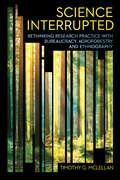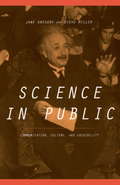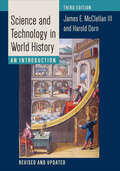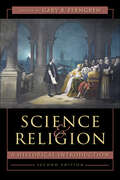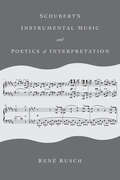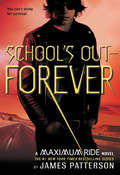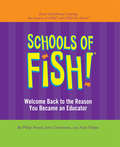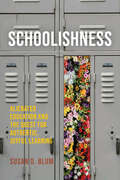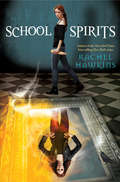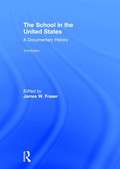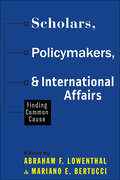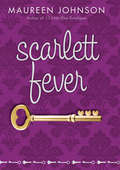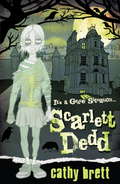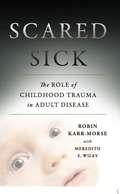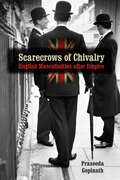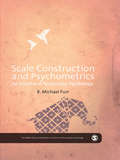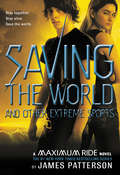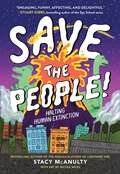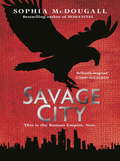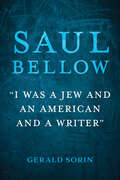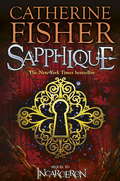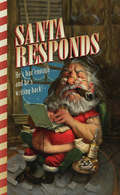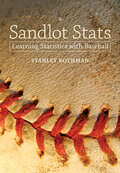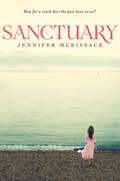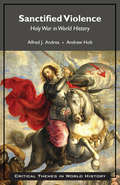- Table View
- List View
Science Interrupted: Rethinking Research Practice with Bureaucracy, Agroforestry, and Ethnography (Expertise: Cultures and Technologies of Knowledge)
by Timothy G. McLellanScience Interrupted examines how scientists in China pursue environmental sustainability within the constraints of domestic and international bureaucracies. Timothy G. McLellan offers a theoretical framework for analyzing the formal procedural work of Chinese bureaucracy—work that is overlooked when China scholars restrict their gaze to the informal and interpersonal channels through which bureaucracy is often navigated. Homing in on an agroforestry research organization in southwest China, the author takes the experiences of the organization's staff in navigating diverse international funding regimes and authoritarian state institutions as entry points for understanding the pervasiveness of bureaucracy in contemporary science. He asks: What if we take the tools, sensibilities, and practices of bureaucracies seriously not only as objects of critique but as resources for re-thinking scientific practice? Extending a mode of anthropological research in which ethnography serves as source of theory as well as source of data, Science Interrupted thinks with, and not only against, bureaucracy. McLellan shows that ethnographic engagement with bureaucracy enables us to imagine more democratic and more collaborative modes of scientific practice.
Science In Public: Communication, Culture, And Credibility
by Jane Gregory Steven MillerDoes the general public need to understand science? And if so, is it scientists' responsibility to communicate? Critics have argued that, despite the huge strides made in technology, we live in a "scientifically illiterate" society--one that thinks about the world and makes important decisions without taking scientific knowledge into account. But is the solution to this "illiteracy" to deluge the layman with scientific information? Or does science news need to be focused around specific issues and organized into stories that are meaningful and relevant to people's lives? In this unprecedented, comprehensive look at a new field, Jane Gregory and Steve Miller point the way to a more effective public understanding of science in the years ahead.
Science and Technology in World History: An Introduction
by James E. McClellan III Harold DornArguably the best general history of science and technology ever published.Tracing the relationship between science and technology from the dawn of civilization to the early twenty-first century, James E. McClellan III and Harold Dorn’s bestselling book argues that technology as "applied science" emerged relatively recently, as industry and governments began funding scientific research that would lead directly to new or improved technologies.McClellan and Dorn identify two great scientific traditions: the useful sciences, which societies patronized from time immemorial, and the exploration of questions about nature itself, which the ancient Greeks originated. The authors examine scientific traditions that took root in China, India, and Central and South America, as well as in a series of Near Eastern empires in late antiquity and the Middle Ages. From this comparative perspective, McClellan and Dorn survey the rise of the West, the Scientific Revolution of the seventeenth century, the Industrial Revolution, and the modern marriage of science and technology. They trace the development of world science and technology today while raising provocative questions about the sustainability of industrial civilization.This new edition of Science and Technology in World History offers an enlarged thematic introduction and significantly extends its treatment of industrial civilization and the technological supersystem built on the modern electrical grid. The Internet and social media receive increased attention. Facts and figures have been thoroughly updated and the work includes a comprehensive Guide to Resources, incorporating the major published literature along with a vetted list of websites and Internet resources for students and lay readers.
Science and Religion: A Historical Introduction
by Gary B. FerngrenAn essential examination of the historical relationship between science and religion.Since its publication in 2002, Science and Religion has proven to be a widely admired survey of the complex relationship of Western religious traditions to science from the beginning of the Christian era to the late twentieth century. In the second edition, eleven new essays expand the scope and enhance the analysis of this enduringly popular book.Tracing the rise of science from its birth in the medieval West through the scientific revolution, the contributors here assess historical changes in scientific understanding brought about by transformations in physics, anthropology, and the neurosciences and major shifts marked by the discoveries of Copernicus, Galileo, Isaac Newton, Charles Darwin, and others. In seeking to appreciate the intersection of scientific discovery and the responses of religious groups, contributors also explore the theological implications of contemporary science and evaluate approaches such as the Bible in science and the modern synthesis in evolution, which are at the center of debates in the historiography, understanding, and application of science.The second edition provides chapters that have been revised to reflect current scholarship along with new chapters that bring fresh perspectives on a diverse range of topics, including new scientific approaches and disciplines and non-Christian traditions such as Judaism, Islam, Asiatic religions, and atheism. This indispensible classroom guide is now more useful than ever before.Contributors: Richard J. Blackwell, Peter J. Bowler, John Hedley Brooke, Glen M. Cooper, Edward B. Davis, Alnoor Dhanani, Diarmid A. Finnegan, Noah Efron, Owen Gingerich, Edward Grant, Steven J. Harris, Matthew S. Hedstrom, John Henry, Peter M. Hess, Edward J. Larsen, Timothy Larson, David C. Lindberg, David N. Livingstone, Craig Martin, Craig Sean McConnell, James Moore, Joshua M. Moritz, Mark A. Noll, Ronald L. Numbers, Richard Olson, Christopher M. Rios, Nicolaas A. Rupke, Michael H. Shank, Stephen David Snobelen, John Stenhouse, Peter J. Susalla, Mariusz Tabaczek, Alan C. Weissenbacher, Stephen P. Weldon, and Tomoko Yoshida
Schubert's Instrumental Music and Poetics of Interpretation
by René RuschMusic scholarship's views of Franz Schubert's instrumental works continue to evolve. How might aesthetic values, historiographies, revisions to the composer's biography, and disciplinary commitments affect how we interpret his music?Schubert's Instrumental Music and Poetics of Interpretation explores the aesthetic positions and operations that underlie critical assessments of Schubert's instrumental works. In six chapters, each devoted to one or two of Schubert's pieces, René Rusch examines the conditions that have prompted scholarship to reevaluate the composer's music and legacy, considers how different conclusions about his music may be reflective of certain aesthetic values, investigates the role of narrative in both music analysis and constructions of history, and explores alternative forms of coherence through updated analyses of the composer's instrumental works. Rusch's observations and comparative analyses address four significant areas of scholarly focus in Schubert studies, including his approach to chromaticism, his unique musical forms, the relationship between his music and biography, and the influence of Beethoven.Drawing from a range of philosophical, hermeneutic, historical, biographical, theoretical, and analytical sources, Schubert's Instrumental Music and Poetics of Interpretation offers readers a unique and innovative foray into the poetics of contemporary analyses of Schubert's instrumental music and develops new ways to engage with his repertoire.
School's Out - Forever: A Maximum Ride Novel (Maximum Ride #2)
by James Patterson"Adventure, fighting, backstabbing and love abound" (VOYA) in this action-packed follow-up to the #1 New York Times blockbuster MAXIMUM RIDE: THE ANGEL EXPERIMENT, now available in paperback. The heart-stopping quest of six winged kids--led by fourteen-year-old Max--to find their parents and investigate the mind-blowing mystery of their ultimate destiny continues when they're taken under the wing of an FBI agent and attempt, for the first time, to live "normal" lives. But going to school and making friends doesn't stop them from being relentlessly hunted by sinister spies, who lead Max to face her most frightening match yet: a new and better version of herself.
Schools of Fish!
by John Christensen Philip Strand Andy HalperIt's two minutes to 8:00. Time to put on your tights and cape. As an educator, every time that bell rings, you face dozens of challenges. Students with overwhelming personal and academic needs. Creativity-stifling mandates. Administrivia. Cynicism. Apathy. The things that keep you from being the educator you want to be. The FISH! Philosophy--four simple principles: Be There, Play, Make Their Day, and Choose Your Attitude--has helped educators around the world build more effective, fulfilling relationships that lead to better learning. It is also backed by tons (OK, about a hundred pounds) of research on classroom management. Schools of FISH! is full of inspiring and instructive stories about people just like you--with hopes and challenges just like yours. It's about real-life heroes who give the best in themselves to help their students find the best in themselves. Schools of FISH! offers practical ideas on classroom management. It addresses the issues you deal with every day--improving learning, respect and personal accountability, self-discipline and internal motivation, and finding ways to make learning more fun. Because you're not just teaching students to learn . . . you're inspiring them to want to learn.
Schoolishness: Alienated Education and the Quest for Authentic, Joyful Learning
by Susan D. BlumIn Schoolishness, Susan D. Blum continues her journey as an anthropologist and educator. The author defines "schoolishness" as educational practices that emphasize packaged "learning," unimaginative teaching, uniformity, constant evaluation by others, arbitrary forms, predetermined time, and artificial boundaries, resulting in personal and educational alienation, dependence, and dread.Drawing on critical, progressive, and feminist pedagogy in conversation with the anthropology of learning, and building on the insights of her two previous books Blum proposes less-schoolish ways of learning in ten dimensions, to lessen the mismatch between learning in school and learning in the wild. She asks, if learning is our human "superpower," why is it so difficult to accomplish in school? In every chapter Blum compares the fake learning of schoolishness with successful examples of authentic learning, including in her own courses, which she scrutinizes critically.Schoolishness is not a pedagogical how-to book, but a theory-based phenomenology of institutional education. It has moral, psychological, and educational arguments against schoolishness that, as Blum notes, "rhymes with foolishness."
School Spirits (A Hex Hall Novel #4)
by Rachel HawkinsFans of Rachel Hawkins' Hex Hall series will shriek with joy over this dark spin-off adventure full of humor, magic, and snark! Fifteen-year-old Izzy Brannick was trained to fight monsters. For centuries, her family has hunted magical creatures. But when Izzy's older sister vanishes without a trace while on a job, Izzy's mom decides they need to take a break. Izzy and her mom move to a new town, but they soon discover it's not as normal as it appears. A series of hauntings has been plaguing the local high school, and Izzy is determined to investigate. But assuming the guise of an average teenager is easier said than done. For a tough girl who's always been on her own, it's strange to suddenly make friends and maybe even have a crush. Can Izzy trust her new friends to help find the secret behind the hauntings before more people get hurt? Rachel Hawkins brings the same delightful wit and charm captured in her New York Times best-selling Hex Hall series. Get ready for more magic, mystery and romance!
The School In The United States: A Documentary History (Third Edition)
by James W. FraserThe School in the United States collects the essential primary documents of the history of education in the United States, from Colonial America to present-day reform efforts. Expertly chosen by historian and education scholar James Fraser, these documents incorporate a wide range of sources, from first-person accounts to textbook excerpts and presidential speeches. As Fraser demonstrates, the history of American education is also a history of national debates and decisions about schooling, and he places the prominent voices of these debates in conversation through carefully curated selections, including the work of famous thinkers like Thomas Jefferson and W. E. B. Dubois, as well as that of ordinary classroom teachers. Organized by era, each chapter begins with a brief introduction intended to spark student interest, while a detailed bibliography suggests opportunities for further research. The School in the United States is comprehensive enough to be used as a main text, but selective enough to be used alongside another while making key readings in the history of American education accessible in a format that encourages students to make their own evaluations as they engage with major historical debates.
Scholars, Policymakers, and International Affairs: Finding Common Cause
by Abraham F. Lowenthal and Mariano E. BertucciHow to strengthen both academic research and international policies by improving the connections between scholars and policymakers.Scholars, Policymakers, and International Affairs shows how to build mutually beneficial connections between the worlds of ideas and action, analysis and policy. Drawing on contributions from top international scholars with policy experience in the United States, Europe, Asia, Canada, and Latin America, as well as senior policymakers throughout the Americas, Abraham F. Lowenthal and Mariano E. Bertucci make the case that scholars can both strengthen their research and contribute to improved policies while protecting academia from the risks of active participation in the policy process.Many scholars believe that policymakers are more interested in processes and outcomes than in understanding causality. Many policymakers believe that scholars are absorbed in abstract and self-referential debates and that they are primarily interested in crafting theories (and impressing other scholars) rather than developing solutions to pressing policy issues.The contributors to this book confront this gap head-on. They do not deny the obstacles to fruitful interaction between scholars and policymakers, but, drawing on their own experience, discuss how these obstacles can be and have been overcome. They present case studies that illustrate how scholars have helped reduce income inequality, promote democratic governance, improve gender equity, target international financial sanctions, manage the Mexico–U.S. border, and enhance inter-American cooperation. These success stories are balanced by studies on why academic analysts have failed to achieve much positive impact on counternarcotics and citizen security policies. The editors’ astute conclusion identifies best practices and provides concrete recommendations to government agencies, international institutions, nongovernmental organizations, and funding sources, as well as to senior university officials, academic departments and centers, think tanks, established scholars, junior faculty, and graduate students.Clearly written and thoughtfully organized, this innovative book provides analytic insights and practical wisdom for those who want to understand how to build more effective connections between the worlds of thought and action.
Scarlett Fever (Scarlett Ser. #2)
by Maureen JohnsonFrom top-selling author Maureen Johnson comes the second book in the trilogy about a girl and her hotel.Ever since Mrs. Amberson, the former-aspiring-actress-turned-agent, entered Scarlett Martin's life, nothing has been the same.She's still in charge of the Empire Suite in her family's hotel, but she's now also Mrs. Amberson's assistant, running around town for her star client, Chelsea - a Broadway star Scarlett's age with a knack for making her feel insignificant.Scarlett's also trying to juggle sophomore year classes, her lab partner who is being just a little TOO nice, and getting over the boy who broke her heart.
Scarlett Dedd
by Cathy BrettYou're dead Scarlett...Previously a poor taste jibe from school frenemies, now a statement of fact. Scarlett is absolutely mortified (in more ways than one) to discover that she's accidentally killed herself while trying to get out of a school trip. Even worse, she's taken her entire family with her.Life as a ghost is pretty dull - if only some of her friends were dead too...
Scared Sick: The Role of Childhood Trauma in Adult Disease
by Robin Karr-Morse Meredith S. WileyThe first years of human life are more important than we ever realized. InScared Sick, Robin Karr-Morse connects psychology, neurobiology, endocrinology, immunology, and genetics to demonstrate how chronic fear in infancy and early childhood- when we are most helpless-lies at the root of common diseases in adulthood. Compassionate and based on the latest research,Scared Sickwill unveil a major public health crisis. Highlighting case studies and cutting-edge scientific findings, Karr- Morse shows how our innate fight-or-flight system can injure us if overworked in the early stages of life. Persistent stress can trigger diabetes, heart disease, obesity, depression, and addiction later on.
Scarecrows of Chivalry: English Masculinities after Empire
by Praseeda GopinathExploring the fate of the ideal of the English gentleman once the empire he was meant to embody declined, Praseeda Gopinath argues that the stylization of English masculinity became the central theme, focus, and conceit for many literary texts that represented the "condition of Britain" in the 1930s and the immediate postwar era. From the early writings of George Orwell and Evelyn Waugh to works by poets and novelists such as Philip Larkin, Ian Fleming, Barbara Pym, and A. S. Byatt, the author shows how Englishmen trafficking in the images of self-restraint, governance, decency, and detachment in the absence of a structuring imperial ethos became what the poet Larkin called "scarecrows of chivalry." Gopinath's study of this masculine ideal under duress reveals the ways in which issues of race, class, and sexuality constructed a gendered narrative of the nation.
Scale Construction and Psychometrics for Social and Personality Psychology: For Social And Personality Psychology (The SAGE Library of Methods in Social and Personality Psychology)
by R. Michael FurrProviding conceptual and practical foundations in scale construction and psychometrics for producers and consumers of social/personality research, this guide covers basic principles, practices, and processes in scale construction, scale evaluation, scale use, and interpretation of research results in the context of psychological measurement. It explains fundamental concepts and methods related to dimensionality, reliability, and validity. In addition, it provides relatively non-technical introductions to special topics and advanced psychometric perspectives such as Confirmatory Factor Analysis, Generalizability Theory, and Item Response Theory. The SAGE Library in Social and Personality Psychology Methods provides students and researchers with an understanding of the methods and techniques essential to conducting cutting-edge research. Each volume within the Library explains a specific topic and has been written by an active scholar (or scholars) with expertise in that particular methodological domain. Assuming no prior knowledge of the topic, the volumes are clear and accessible for all readers. In each volume, a topic is introduced, applications are discussed, and readers are led step by step through worked examples. In addition, advice about how to interpret and prepare results for publication are presented.
Saving the World and Other Extreme Sports: A Maximum Ride Novel (Maximum Ride #3)
by James PattersonIn MAXIMUM RIDE: SAVING THE WORLD AND OTHER EXTREME SPORTS, the time has arrived for Max and her winged "Flock" to face their ultimate enemy and discover their original purpose: to defeat the takeover of "Re-evolution", a sinister experiment to re-engineer a select population into a scientifically superior master race. . . and to terminate the rest. Max, Fang, Iggy, Nudge, Gasman, and Angel have always worked together to defeat the forces working against them--but can they save the world when they are torn apart, living in hiding and captivity, halfway across the globe from one another?
Save the People!: Halting Human Extinction
by Stacy McAnulty"Save the People is engaging, funny, affecting and delightful. You&’ll never have more fun learning science." --Stuart Gibbs, bestselling author of the Spy School series "Serious science and great gags, with a bit of hope thrown in.&” --Steven Sheinkin, bestselling author of Bomb and FalloutAn action-packed look at past, present, and future threats to humanity&’s survival—with an ultimately reassuring message that humans probably have a few more millennia in us.Scientists estimate that 99% of all species that have ever existed are now extinct. Whoa. So, it's not unreasonable to predict humans are doomed to become fossil records as well. But what could lead to our demise? Supervolcanos? Asteroids? The sun going dark? Climate change? All the above?! Humans—with our big brains, opposable thumbs, and speedy Wi-Fi—may be capable of avoiding most of these nightmares. (The T. rex would be super jealous of our satellites.) But we're also capable of triggering world-ending events. Learning from past catastrophes may be the best way to avoid future disasters. Packed with science, jokes, and black and white illustrations, Save the People! examines the worst-case scenarios that could (but hopefully won&’t) cause the greatest mass extinction—our own!
Savage City: Volume III
by Sophia McDougallImagine a world in which Rome never fell. Now the Empire stretches across the Atlantic, slaves are constructing a giant bridge over the Persian Gulf, and magnetic railways span the globe. But tensions within and without are about to change the face of the earth.Marcus Novius is caught in a massive explosion at the Coliseum which kills his uncle the emperor ... making Marcus, his heir, the new leader of the Roman Empire. Marcus, the healer Sulien and Una, his sister - and Marcus' own love - have been together through thick and thin, fighting for freedom, fighting for their lives, fighting for justice, and Marcus' ascension to Roman throne was supposed to be the start of something magnificent ...But Marcus is horribly wounded himself in the explosion, and Sulien is having problems fighting his way through the terrible devastation to be at his friend's - his emperor's - side. And it's not long before Sulien and Una realise life will never be the same again, for the Roman Empire is about to face its most dangerous enemy ...
Saul Bellow: "I Was a Jew and an American and a Writer" (The Modern Jewish Experience)
by Gerald SorinSaul Bellow: "I Was a Jew and an American and a Writer" offers a fresh and original perspective on the life and works of Saul Bellow, the Nobel Prize winner in Literature in 1976. Author Gerald Sorin emphasizes Bellow's Jewish identity as fundamental to his being and the content and meaning of his fiction. Bellow's work from the 1940s to 2000, when he wrote his last novel at the age of 84, centers on the command in Deuteronomy to "Choose life" as distinct from nihilistic withdrawal and the defense of meaninglessness.Although Bellow disdained the label of "American Jewish Writer," Sorin conjectures that he was an outstanding representative of the classification. Bellow and the characters in his fiction not only choose life but also explore what it means to live a good life, however difficult that may be to define, and regardless of how much harder it is to achieve. For Sorin, Bellow realized that at least two obstacles stood in the way: the imperfection of the world and the frailty of the human pursuer.Saul Bellow: "I Was a Jew and an American and a Writer" provides a new and insightful narrative of the life and works of Saul Bellow. By using Bellow's deeply internalized Jewishness and his remarkable imagination and creativity as a lens, Sorin examines how he captured the shifting atmosphere of postwar American culture.
Sapphique
by Catherine FisherFinn has escaped from the terrible living Prison of Incarceron, but its memory torments him, because his brother Keiro is still inside. Outside, Claudia insists he must be king, but Finn doubts even his own identity. Is he the lost prince Giles? Or are his memories no more than another construct of his imprisonment? And can you be free if your friends are still captive? Can you be free if your world is frozen in time? Can you be free if you don't even know who you areInside Incarceron, has the crazy sorcerer Rix really found the Glove of Sapphique, the only man the Prison ever loved. Sapphique, whose image fires Incarceron with the desire to escape its own nature. If Keiro steals the glove, will he bring destruction to the world? Inside. Outside. All seeking freedom. Like Sapphique.
Santa Responds: He's Had Enough...and He's Writing Back!
by Santa ClausEver wonder what Santa does with all those letters? (And all those cookies?) After a particularly long, cold night staring at nine smelly reindeer butts, the old man lets loose with the real answers to those stupid, whiny, hard-to-read letters from kids. <P><P> Turns out, we really do get what we deserve. Dear Billy, I know you honestly believe that the good deeds you rattled off represent your behavior for the entire past year rather than the activities that occurred during the two hours leading up to the writing of this letter. Two hours of good behavior hardly justifies a new Playstation, let alone a trip to Disney World Your pal, Santa
Sandlot Stats: Learning Statistics with Baseball
by Stanley RothmanSandlot Stats uses the national pastime to help students who love baseball learn—and enjoy—statistics.As Derek Jeter strolls toward the plate, the announcer tosses out a smattering of statistics—from hitting streaks to batting averages. But what do the numbers mean? And how can America’s favorite pastime be a model for learning about statistics? Sandlot Stats is an innovative textbook that explains the mathematical underpinnings of baseball so that students can understand the world of statistics and probability. Carefully illustrated and filled with exercises and examples, this book teaches the fundamentals of probability and statistics through the feats of baseball legends such as Hank Aaron, Joe DiMaggio, and Ted Williams—and more recent players such as Barry Bonds, Albert Pujols, and Alex Rodriguez. Exercises require only pen-and-paper or Microsoft Excel to perform the analyses.Sandlot Stats covers all the bases, including• descriptive and inferential statistics• linear regression and correlation• probability• sports betting• probability distribution functions• sampling distributions• hypothesis testing• confidence intervals• chi-square distributionSandlot Stats offers information covered in most introductory statistics books, yet is peppered with interesting facts from the history of baseball to enhance the interest of the student and make learning fun.
Sanctuary
by Ms. Jennifer McKissackA haunting and luminous Gothic YA novel about reckoning with the ghosts of one's dark past.After the untimely death of her aunt Laura, Cecilia Cross is forced to return to Sanctuary, a rambling, old French-Gothic mansion that crowns a remote island off the coast of Maine. Cecilia is both drawn to and repulsed by Sanctuary. The scent of the ocean intoxicates her, but she's also haunted by the ghosts of her past -- of her father who died at Sanctuary five years ago, and of her mother who was committed soon after. The memories leave Cecilia feeling shaken, desperate to run away and forget her terrible family history.But then a mysterious guest arrives at Sanctuary: Eli Bauer, a professor sent to examine Sanctuary's library. Cecilia is intrigued by this strange young man who seems so interested in her -- even more interested in her than in the books he is meant to be studying. Who is he and what does he want? Can Cecilia possibly trust her growing feelings for him? And can he help her make peace with her haunted, tragic past?
Sanctified Violence: Holy War in World History (Critical Themes in World History)
by Alfred J. Andrea Andrew Holt"This rich and engaging book looks at instances of sanctified violence, the holy wars related to religion. It covers it all, from ancient to present day, including examples of warfare among Sikhs, Hindus and Buddhists, as well as Christians, Jews and Muslims. It is a comprehensive and readable overview that provides a lively introduction to the subject of holy war in its broadest sense—as &‘sanctified violence&’ in the service of a god or ideology. It is certain to be a useful companion in the classroom, and a boon to anyone fascinated by the dark attraction of religion and violence." —Mark Juergensmeyer, University of California, Santa BarbaraContents:Introduction: What Is Holy War?Chapter 1: Holy Wars in Mythic Time, Holy Wars as Metaphor, Holy Wars as RitualChapter 2: Holy Wars of Conquest in the Name of a DeityChapter 3: Holy Wars in Defense of the SacredChapter 4: Holy Wars in Anticipation of the Millennium Epilogue: Holy Wars Today and TomorrowAlso included are a description of the Critical Themes in World History series, Preface, index, and suggestions for further reading.
